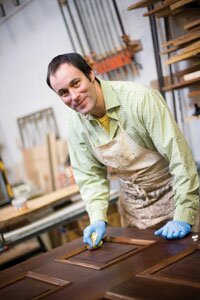ONETIME- Lord of the rings: A furniture finishing tale

Michael Keith Michael Restoration, as told to Justin Humphreys
PHOTO BY WILL WALKER
One time, I heard about an old furniture finisher who created an air of mystery about his work, especially when he removed moisture rings from furniture.
He would shoo people out of the room where the furniture was, close the doors, and wouldn't allow anyone to watch. Then he would take mentholated spirits (or denatured alcohol) and would pour as much around the little white ring on the furniture as he could. Not much alcohol– just enough to follow the ring.
And then he would wait a few seconds— enough time for the alcohol to start breaking into the finish's surface, open it up, and expose the moisture layer causing the ring. And then, with a match, like a flambé dessert, he would set it ablaze.
When you light alcohol, it evaporates as it burns, and it will remain cool against a surface until it has fully evaporated. When it gets to that hot point before it burns the polish, he would blow it out. The liquid alcohol has opened the surface up and then, by igniting it, it draws the moisture out.
The heat also helps to transform the moisture into steam; as it's drawn out, it evaporates quickly. If you then blow it out, if there's any alcohol left, it will just evaporate. Then that polish will just re-settle, flatten, and seal.
In his toolbox, there weren't any sophisticated tools– just his thermos. He would have a cup of tea, sit back, and read his newspaper for fifteen minutes. Then he would get out his French polish kit, put a coat of polish over top, let it dry, put some wax over it, and— presto— the ring is gone!
This is something I would not advise you to do in your own home, and only with something that you know is French polish finish. Other things are not going to take kindly to that treatment.
To deal with moisture rings, usually if it's a fairly low-level ring in the furniture's finish, you can rub over it with super-fine steel wool. In much of finishing, you should treat the whole surface as you would just that one spot, so you don't want to rub hard just where the ring is, because you'll wear a deeper spot in that one area, making the surface uneven.
You want to go over the whole table, but focusing on that ring. Use steel wool lightly, going with the grain, and it will take the first layer of wax off, and hopefully take the first couple of layers of polish off, too. It should remove the ring.
Then you can use a paste wax, which is applied somewhat like shoe polish: you apply it, let it dry, then rub it off with a cloth that doesn't have to be super-clean. Then use a really clean one to get the final smeared wax.
It's much safer than creating your own bunson burner.
#